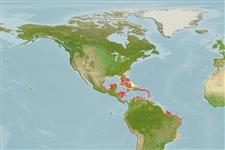Common names from other countries
Demospongiae |
Poecilosclerida |
Microcionidae
Environment: milieu / climate zone / depth range / distribution range
Ecology
Sessile; brackish; depth range 1 - 30 m (Ref. 86836). Tropical; 25°C - 33°C (Ref. 86836)
Western Central Atlantic.
Length at first maturity / Size / Weight / Age
Maturity: Lm ? range ? - ? cm Max length : 0.2 cm OT male/unsexed; (Ref. 415)
Thin crust: 0.1 - 0.2 thickness. Gray to cream externally and internally. Oscule with transparent membranes; 0.3 - 0.4 cm in diameter, from which thin canals 0.1 cm depart radially. Smooth and slippery surface (Ref. 415).
Maximum thickness: 0.2 cm (Ref. 415). Maximum depth from Ref. 114712. Common to rare on mangrove roots (Ref. 415).
Life cycle and mating behavior
Maturity | Reproduction | Spawning | Eggs | Fecundity | Larvae
Members of the class Demospongiae are hermaphroditic. Life cycle: The zygote develops into parenchymella larva (free-swimming) before settling down on a substrate where it grows into a young sponge.
Collin, R., M.C. Díaz, J. Norenburg, R.M. Rocha, J.A. Sánchez, M. Schulze, A. Schwartz and A. Valdés. 2005. (Ref. 415)
IUCN Red List Status
(Ref. 130435: Version 2025-1)
CITES status (Ref. 108899)
Not Evaluated
Not Evaluated
Threat to humans
Harmless
Human uses
| FishSource |
Tools
More information
Trophic EcologyFood items (preys)
Diet composition
Food consumption
Predators
Population dynamicsGrowth
Max. ages / sizes
Length-weight rel.
Length-length rel.
Length-frequencies
Mass conversion
Abundance
Life cycleReproductionMaturityFecunditySpawningEggsEgg developmentLarvae PhysiologyOxygen consumption
Human RelatedStamps, coins, misc.
Internet sources
Estimates based on models
Preferred temperature
(Ref.
115969): 26.3 - 28.4, mean 27.2 (based on 199 cells).
Fishing Vulnerability
Low vulnerability (10 of 100).
Price category
Unknown.
